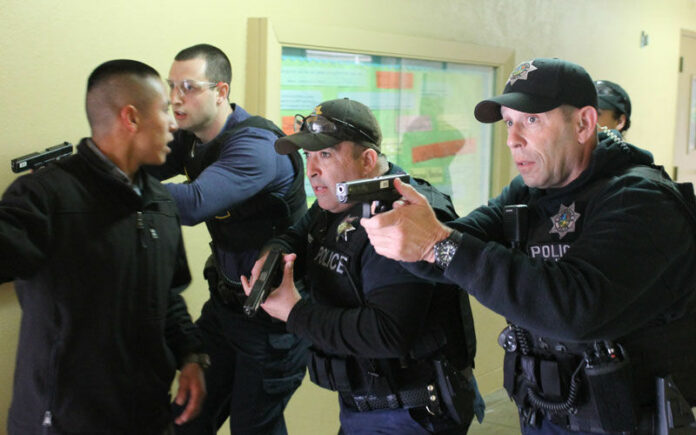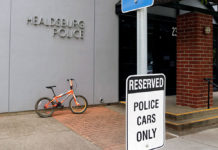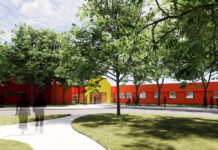Local law enforcement training for worst-case scenario at Cloverdale school
“Help us, somebody help!” The scream rips through the dripping mist.
“Why aren’t you helping us?” the voice is ragged, painful. “He’s been shot, he’s dying, help!”
The officers approach in a tight bunch, guns cocked. They call out positions to each other, and then call “Clear!”
A terrified student bursts from a classroom, screaming, “He’s going to kill me!” The officers raise their guns and start shouting out commands. Radios crackle, barely audible above the shouts. Shots ring out, so loud they are felt as much as they are heard. More screams. A teacher lies in the hallway, moaning, with a bone sticking up through their skin and shirt. A student lays in a doorway, a gunshot wound horrifically prominent on their forehead.
Teams of paramedics arrive, crouching behind police officers who guard them, guns at the ready. “Is this your blood or someone else’s,” they ask. “Are you hurt?”
Gunfire explodes again and everybody hits the deck, radios explode. A line of students comes flying around a corner with their hands behind their heads.
“Keep ‘em up,” shouts out an officer.
A young man pleads with a paramedic to help his friend, but the paramedic gently shakes his and applies the tag that indicates the boy is deceased.
“And … we’re clear,” a voice calls out, echoing on the radio. Another officer, this one not dressed in the same combat gear the other officers are sporting comes forward.
“Good job everybody.”
The deceased come back to life, sitting up carefully, trying not to bump their fake wounds. It has been nothing but a bit of high-stress make believe. There is no crazed shooter; no students or teachers have been injured. The guns are all either disabled or loaded with blanks.
It was all part of active shooter training, a continuing education opportunity for local law enforcement and rescue agencies that recreates the horror and chaos of a school shooter scenario. On March 24, Cloverdale Police, Cloverdale Fire, Healdsburg Police, the Sonoma County Sheriff’s Department and several local paramedic and fire rescue crews converged at the Citrus Fairgrounds in Cloverdale and at nearby Washington Middle School to experience multiple scenarios and practice their response. Also in attendance, to add realism to practice, were volunteer teachers, students and community members who were there to play victims. Many of them were assigned specific roles and given compelling makeup jobs to match their injuries.
“Its so incredibly valuable to be able to do this and for Cloverdale to be able to host it,” said Cloverdale Chief of Police Stephen Cramer. “Now we just hope to God we never use it.”
“I think it’s great, just extremely beneficial,” said officer Rosendo Castro from the Healdsburg Police department. “You can never be truly prepared for something like that, but having that sort of experience is amazing. It shows how incredibly hectic it is, but also how the multiple agencies can and should work together. It’s intimidating, but that experience will benefit everybody.”
Castro said he had done other smaller scale active shooter trainings previously, but nothing quite so large and immersive.
The eerily realistic scenarios start with a 911 call, so that dispatchers and incident commanders can practice their roles as well. “Oh my god, help, at Washington, he’s shooting kids, kids are shot,” a sheriff’s deputy running the scenario screams into the phone, his voice wavering with terror.” Hurry!”
Various units practice moving through the school, clearing rooms and hallways one by one. They practice ignoring the horror and chaos to concentrate on finding and neutralizing the shooter. They practice ignoring screams of: “You’re the police, why aren’t you helping us?”
The paramedics and firefighters practice triaging victims, examining shell-shocked kids for injuries and classifying the wounded. Sometimes this means leaving behind those who are assigned to play dead victims. All of them practice working together, paramedics relaying information gleaned from students back to officers.
They run three scenarios: the first is loud and chaotic, a mass shooter firing indiscriminately. The second is the opposite, but no less anxiety inducing — a shooter with a specific target who takes hostages, then ultimately, his own life. In the eerie silence, the tension is palpable as officers surround the classroom with all the shades pulled and rapidly decide how to respond.
The final scenario is by far the most chilling. A wounded boy being attended to in triage screams, “Colin! Where’s Colin? Where’s my brother?”
He calls to other students around him,” Have you seen Colin? Where’s my brother, I can’t go home without him.” A few students offer what they know, he was last seen in the area where shots were heard.
“Please,” he pleads to the paramedics. “Where’s my brother, you have to find him, Colin!”
The paramedics ask what he was wearing and radio the police officers, “We have a missing juvenile; red jacket, blue jeans.”
Radios crackle, and the response causes everyone to go silent, even though it’s all make believe.
Colin was the shooter.
73.7
F
Healdsburg
May 25, 2025










